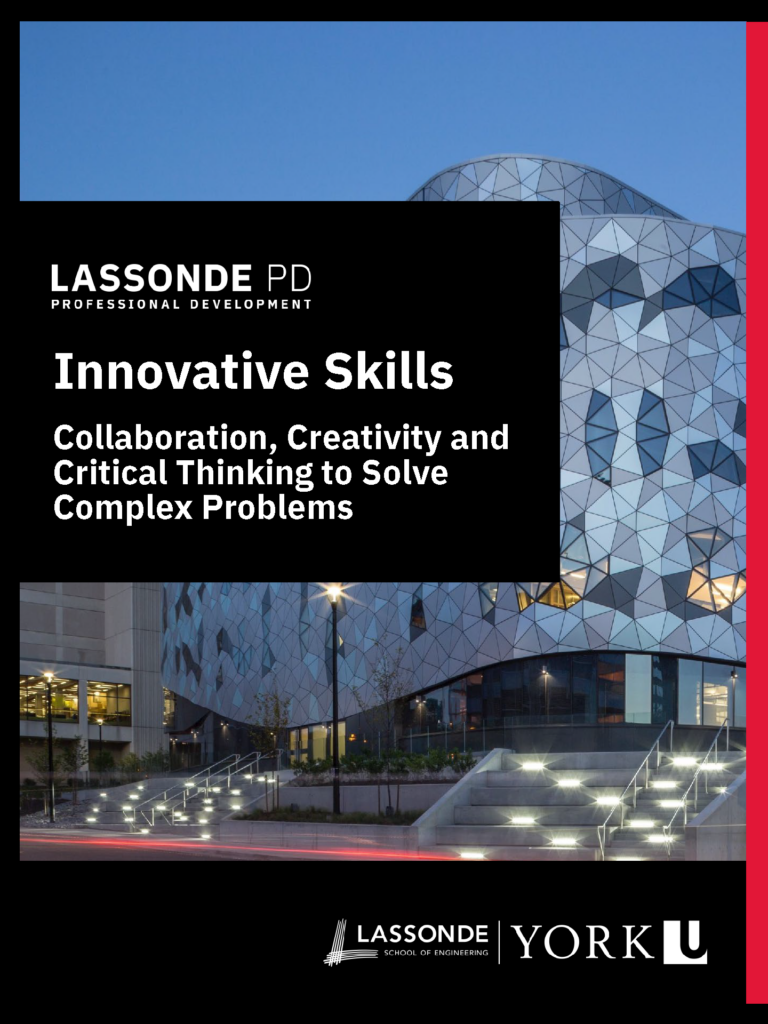Program Length
6 chapters/40 minutes each
Program Dates
TBD
Program Format
E-learning, self-paced
Tuition and Fees
TBD
Prerequisites
Exposure to issues of problem solving and innovation
hi
Course Overview
The course derives from the ‘Future of Jobs’ report of the World Economic Forum (WEF), which shows the primary competencies we need today and in the coming years. Innovation and Complex Problem Solving are at the top of the list. Over a third of all jobs across all industries will require these skills. This course will explain the primary competencies in the report, how they link together and how they enable innovation. Creativity, critical thinking and collaboration are the skills the innovator needs to solve complex problems. These skills are in turn supported by Emotional Intelligence which includes resilience and flexibility. Leadership integrates the skills in the list to ensure solution delivery. Important projections in the WEF report are the increased need for learning strategies and active learning, which this course provides.

Who Should Attend?
Participants in problem-solving and innovation roles seeking to enhance their related knowledge and skills competence.
What You Will Learn
The course will provide increased subject knowledge in the following areas:
1. Complex Problem Solving – an understanding of the complexity
2. Emotional Intelligence – an initiation plan to increase E.I.
3. Critical Thinking – competence in the basics of critical thinking
4. Collaboration – the development of a personal knowledge
5. Creativity – competence in the basics of creative problem solving
6. Leadership – understanding the leadership role in complex problem solving
We innovate in a complex environment and innovators solve complex problems. This chapter will explore the nature of complexity and the essential steps for solving complex problems. Complexity arises with a set of interrelated & interacting elements which are generally processes, people and technology. There is a tendency to focus on process problems and innovators need a system approach. There are many layers in a system and innovators travel through complexity, use collective knowledge, creativity and critical thinking to solve complex problems.
Chapter 2: Collaboration and diversity
We learn quickly that we cannot solve complex problems on our own and that collaboration is needed to create collective knowledge. Collaboration finds the larger body of knowledge needed for radical solutions. This chapter will explain the nature of networks and the techniques for collaboration. Open networking is used to share knowledge, release the collective subconscious and create new knowledge. There is a lower correlation between IQ and problem solving than between diversity and the ability to solve problems. Linus Pauling attributes his Nobel Prize to better collaboration and not better intellect.
Chapter 3: Emotional Intelligence to work together
Emotional Intelligence enables better collaboration. This chapter will explain the basic principles of Emotional Intelligence and how to develop it. EI helps manage emotions that drive our own, and others, behaviour and reduces the tensions which arise in diversity. Elements of EI are self-awareness and knowledge of what you feel and why we feel it, self-management and the ability to express feelings in the right way. Developing motivation gives the internal drive to change the way we feel and expressing empathy means seeing issues from other’s perspective. The outcome is social skills which enable us to communicate and build strong connections. EI development takes time but the payback is significant.
Chapter 4: Creativity to find alternative solutions
This chapter will explain the attributes of creative people and the techniques for releasing our own natural creativity. Creative people adventure, explore and take risks and will give many responses to questions. Creativity comes from Imagination and unconventional approaches and releases when we think freely and unlock the subconscious mind. We’re born creative but daily work removes the freedom to be creative. We can restore creativity through activities such as theatre, writing, music and painting. Techniques for finding creative solutions are outlined. This need in business has been borne out by research such as the IBM CEO Survey and PWC CEO survey.
Chapter 5: Critical Thinking to select solutions
This chapter will outline the approach for critical thinking and provide illustrations of critical thinking techniques. It is the approach used for selecting a preferred solution from the alternative solutions developed through creativity. The earliest record of critical thinking is from Socrates and the term ’’critical’’ derives from Greek roots ’kriticos’ (discerning judgment) and “kriterion” (standards). Critical thinking is “discerning judgment based on standards.” It involves analysis and reconstructing facts to form a judgment. A Critical Thinker evaluates arguments and identifies inconsistencies and errors. They exercise judgement in decision making, converging to a consensus and finding the best path forward
Chapter 6: Leadership of the process
Leadership is not just a title, it is an attribute and an activity. This chapter will explain the leaders role as an innovator and in developing solutions to complex problems. Leaders challenge the status quo, are driven by curiosity and courage, and they inspire and engage people. Leaders understand an organization’s behaviours, recognizing key behaviours and engaging people to develop solutions. They may not directly involve in creativity, but they should ensure strategy flows. In the creative phase, leaders should observe, learn and understand even if they don’t feel creative.

Download Course Brochure
Faculty
Program Director

Peter Merrill is a sought-after speaker on Innovation and regularly keynotes at events like the World Conference on Quality. As Chief Executive of one of the leading design brands in Europe, he is known to be an innovator in what is also known to be a very competitive market. He is an Engineer, an artist and a writer, regularly playing a leading role in Innovation in Graphic Art and in Engineering. He is the author of three key books in these fields, Innovation Generation, Do It Right the Second Time, and Innovation Never Stops..
eeee
eee